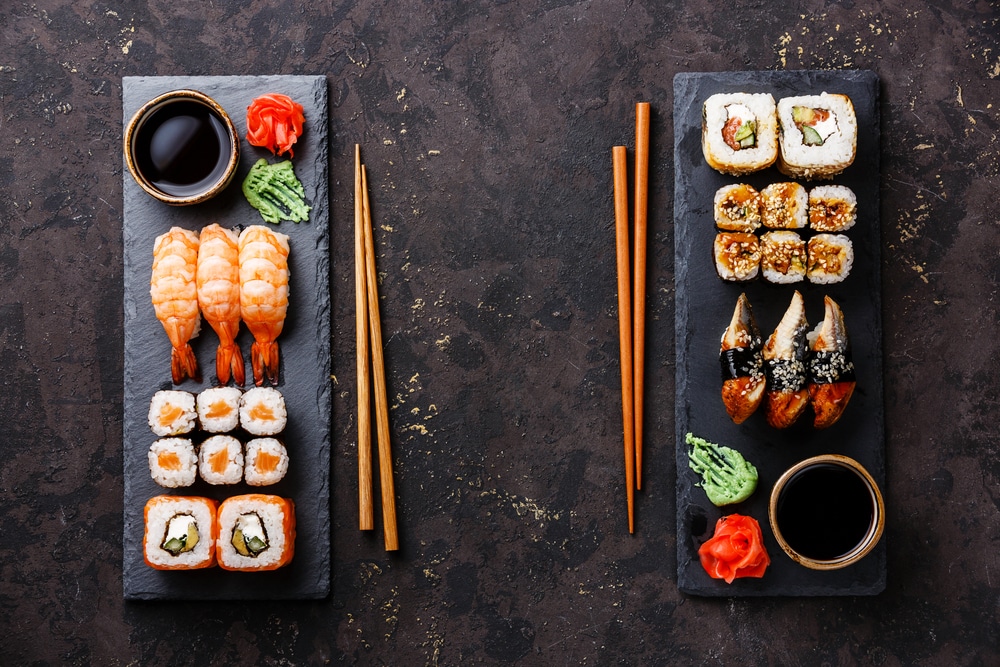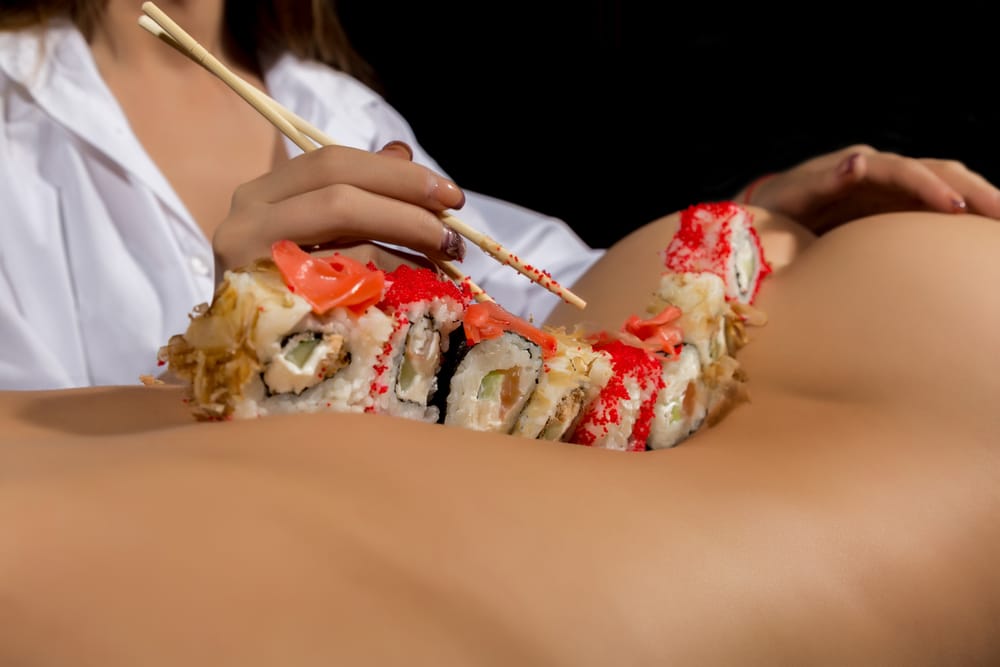Sushi is a globally recognized emblem of culinary talent and cross-cultural unity in a world where food has evolved beyond simple nourishment to become a lively language in and of itself. In addition to winning over people’s hearts and palates all around the world with its finely constructed Japanese heritage, dining together has helped to overcome cultural divides. This is never more apparent than in the glittering metropolis of Las Vegas, where the customary collides with the unusual in a gastronomic scene as varied and vibrant as its patrons.
Las Vegas provides a special canvas for the evolution of sushi art because of its glistening lights and endless excitement. Here, sushi transcends from its simple beginnings to provide a variety of experiences to suit every palate and whim. Explore the depths and breadth of this culinary heritage in the city, which offers intimate settings at real sushi bars as well as the daring and inventive practices of Nyotaimori and Nantaimori, where sushi is presented on human bodies. These customs, which have their origins in Japanese culture, are reinterpreted in Las Vegas by fusing a love of spectacle and sensual enjoyment with a respect for tradition.
Sushi’s journey in Las Vegas is more than just a narrative of culinary innovation; it’s evidence of the city’s status as a melting pot of cultures, where food serves as a vehicle for creative expression, interpersonal communication, and storytelling. We learn that every roll and every piece of sushi, as we explore the art of sushi in this colorful oasis in the desert, is a tale of artistry, tradition, and the shared desire for beauty and connection through food. Sushi in Las Vegas is a call to globalize, discover the artistic expression of many civilizations, and commemorate the universal human experience of sharing a meal with others. This is the tale of sushi in Las Vegas, a gastronomic discovery and blending of cultures come to life.

The Art of Sushi – Beyond the Roll
Sushi preparation is an exquisite art form that reflects the careful and respectful attitude toward food that permeates much of Japanese cuisine. With its origins firmly ingrained in Japanese history and culture, this culinary tradition is much more than just a way to prepare food; it is an art form built around the principles of presentation, taste, and tradition. Sushi making is a delicate ballet of tastes, textures, and aesthetics, where each component is carefully picked and each piece is expertly created. In addition to being a cook, the sushi chef, or itamae, is an artist who spends years honing the knife skills, rice seasoning, and fish selection required to produce these delectable works of art.
However, sushi’s journey continues beyond the fish market and rice paddies as it adopts fresh shapes and emotions that appeal to people all over the world. Among the most fascinating and thought-provoking variations of sushi art are the traditions of Nyotaimori and Nantaimori, which involve presenting sushi on a human body. Traditionally, Nantaimori employs a male body as the serving dish while Nyotaimori carefully arranges sushi on a female body. By fusing the visual and gustatory in a way that defies accepted eating conventions and draws the diner into a multimodal investigation, these techniques take dining to a whole new level.
Beyond being distinctive places to eat, Nyotaimori and Nantaimori also function as forums for cross-cultural discussion and sensory investigation. They extend an invitation to diners to reflect on the significance of tradition, art, and beauty in an unconventional environment. This pushes boundaries and initiates conversations about the bounds of culinary expression by fusing traditional sushi craftsmanship with the human body as a painting. By doing this, it provides a singular chance to investigate the relationship between food, art, and human aesthetics via a shared, social encounter.
The arrival of Nyotaimori and Nantaimori on the culinary landscape is a testament to the adaptability and growth of sushi in many settings. These methods highlight the value of transparency in culinary inquiry by enticing the artist and the viewer to interact respectfully and creatively with food and tradition. Sushi carries with it the spirit of its rich tradition even as it continues to expand beyond the roll, encouraging everyone to savor the depth of its cultural importance, the harmony of tastes, and the beauty of presentation.
Las Vegas – A Melting Pot of Culinary Experience
In addition to being well-known for its bright lights and never-ending entertainment, Las Vegas is also well-known for its diverse culinary scene, which is a veritable melting pot of international cuisine. The city’s eating sector, which offers a variety of culinary experiences ranging from high-end, Michelin-starred restaurants to real street cuisine, is a monument to its embracing of cultures from across the world. This vibrant tapestry of flavors not only captures the tastes of people all around the world, but also highlights Las Vegas’s distinct penchant for culinary experimentation and creativity.
The foundation of this gastronomic diversity is Las Vegas’s willingness to try out novel eating ideas, which consistently push the limits of conventional dining encounters. The most fascinating of them is the art of Nyotaimori and Nantaimori, also known as naked sushi, in which the sushi maker uses the subject’s body as a canvas. This distinctive dining experience delivers more than just cuisine; it’s an immersive encounter that combines culinary brilliance with visual creativity, grounded in Japanese culture but imbued with the avant-garde spirit of Las Vegas.
Not only is naked sushi unique in Las Vegas, but it also has the power to produce an unforgettable eating experience that awakens the senses in a whole new way. It’s a daring representation of the city’s gastronomic culture, capturing the excitement of finding the unanticipated and the spirit of discovery. The acceptance and enjoyment of these out-of-the-ordinary eating experiences in Las Vegas is a testament to the city’s dedication to culinary variety and innovation.
The culinary scene in Las Vegas is a vibrant place where innovation and tradition meet to create one-of-a-kind experiences that are as tasty as they are varied. The city acts as a platform for culinary innovation, enabling both locals and visitors to explore, taste, and revel in the limitless possibilities that this culinary melting pot has to offer. From the kitchens of renowned chefs to the intimate settings of naked sushi encounters.
With so many different eating ideas, Las Vegas not only provides a window into different culinary cultures but also encourages guests to broaden their perspectives and try new things. For food connoisseurs looking to experience the cutting edge of eating, Las Vegas is a must-visit location because of its openness to culinary innovation. With experiences that promise to tickle the palette and spark the imagination, Las Vegas encourages everyone to engage in its great culinary journey, whether it is through the creative presentation of Nyotaimori and Nantaimori or the careful balance of flavors in a sushi roll.
Connecting Cultures – Nyotaimori and Nantaimori in the Desert
The traditional Japanese customs of Nyotaimori and Nantaimori find a new home in the middle of the desert, where the neon lights of Las Vegas shine like a beacon of limitless possibilities. They blend in well with the city’s famous tapestry of culinary innovation and cultural extravaganza. This adaption is a dynamic illustration of how Las Vegas honors and enriches international culinary skills, reframing them within its distinct, dynamic setting, rather than just transplanting a foreign legacy onto American soil.
Often referred to as “naked sushi,” nyotaimori and nantaimori are the meticulous placement of sushi on the bodies of either male or female models, transforming a meal into a work of art that is alive. From its historical beginnings, this samurai-rooted custom has developed to represent exclusivity and elegance in contemporary eating. These experiences are reinvented in Las Vegas to showcase the city’s flare for the spectacular, fusing the precise craft of sushi with the theatrical dining culture that makes Vegas famous. This is where the novelty of these techniques gives way to immersive experiences that encourage guests to investigate the connections between art, culture, and food.
In Las Vegas, eating sushi off someone is as much about the show as it is about the close relationship it creates between different cultures. Participants get the chance to interact with a custom that may not be typical of them, treating it with respect and interest. In Las Vegas, where variety and creativity are valued, this act of cultural appreciation is enhanced. It turns into a shared, personal experience based on respect for each other’s bodies and the craftsmanship of sushi. In a ritual that honors the body as a painting and the sushi as an extension of cultural expression, both diners and models participate.
Nyotaimori and Nantaimori in Las Vegas serve as a link between the old and the new, the known and the unknown. They encourage customers to discover the intricate web of Japanese culture by engaging in an old but cutting-edge technique. Consequently, these encounters capture the essence of Las Vegas itself: a location where cultures converge to produce unanticipated beauty and a sense of human connection.
Through the incorporation of these customs into its culinary scene, Las Vegas not only pays homage to the traditions that inspire it, but also reimagines them, resulting in a novel mode of cross-cultural interaction. It’s evidence of the city’s capacity to welcome and celebrate the various cultures that meet inside its boundaries and turns it into a veritable melting pot of inventive cuisine and culture.

Personal Connections Through Shared Experiences
Sushi dining is a surprising place in the center of Las Vegas, away from the bright lights and busy casinos, where people can engage on a deep personal level. This city provides a unique combination of classic sushi bars and more private, avant-garde experiences like Nyotaimori and Nantaimori, where sushi is served on the human body. It is renowned for its unmatched entertainment and gastronomic diversity. These dining encounters are more than just meals; they provide a unique and valuable sense of intimacy, camaraderie, and shared human experience.
In Las Vegas, traditional sushi bars function as social gathering places where customers—many of whom were strangers before entering the establishment—can connect over their mutual love of sushi. The open design of the sushi bar fosters conversation between diners and sushi chefs, transforming the meal into a vibrant discussion of laughs, tales, and gourmet tastes. These exchanges frequently result in lifelong friendships, and patrons come back for the wonderful cuisine as well as the cozy, social ambiance that elevates an ordinary lunch into a joyful occasion.
Even though they are more specialized, Nyotaimori and Nantaimori go beyond this community aspect. These customs, which have their roots in Japanese culture but have been reimagined in the vibrant and welcoming atmosphere of Las Vegas, provide a distinctive eating experience that is as much about the beauty and art of human interaction as it is about sushi. A meal is presented to diners on a human body; this is an act that is fundamentally about trust, respect, and honoring the human form and artistic expression. Diners may have intelligent, honest discussions about art, culture, and the mutual respect and vulnerability that come with the experience in this context.
Testimonials from participants in Las Vegas’ Nyotaimori and Nantaimori programs frequently highlight the significant effects of these experiences. Customers spoke of having a strong sense of connection to the chefs and models who provide this kind of experience, as well as to the other diners they are dining with. They discuss how they come to appreciate and admire the chefs’ talent and the models’ bravery for working together to create a live piece of art. Such encounters have the power to alter diners’ perspectives and foster a more profound comprehension of respect, consent, and the beauty of accepting human vulnerability.
In Nyotaimori and Nantaimori, models and performers express their personal narratives of connection, emphasizing their faith in the cooks and the diners. They describe it as an empowering experience and a chance to participate in a custom that honors the human body as a medium for culinary art. The diners, cooks, and models all treat one other with mutual respect, which turns the dinner into a collaborative performance in which each person contributes to the creation of a beautiful, meaningful, and appreciative moment.
Dining becomes a vehicle for overcoming divides and creating friendships in surprising ways in Las Vegas. From the busy sushi bars to the calm, contemplative moments of a Nyotaimori or Nantaimori dinner, each mouthful turns into a communal experience, a narrative shared with others, and a memory created deep in the desert. It serves as a reminder that, even in a city renowned for its spectacles, the most meaningful encounters can result from the straightforward act of dining together and becoming receptive to the lives and tales of people around us.
Sushi sticks out in the vast tapestry of world cuisine as evidence of the ability of food to bridge cultural divides and unite people. It’s a kind of cooking that allows for artistic expression while respecting the simplicity and purity of its materials. Sushi symbolizes a beautiful balance between the familiar and the unfamiliar, from the expertly prepared nigiri to the avant-garde presentations of Nyotaimori and Nantaimori. It invites us all to discover the depths of its culinary legacy and the range of its current interpretations.
The bustling sushi scene in Las Vegas, a city known for its bright lights and endless activity, reflects this balance. Here, the city’s flare for the spectacular blends with traditional Japanese methods to create a gastronomic environment where sushi acts as a link between different cultures. Here, enjoying a sushi dinner may turn into an exploration that takes us through the colorful past of this age-old dish while also revealing the creative energy that is bringing it into the present.
Sushi allows us to connect with the people and stories that bring it to life in Las Vegas today, as well as with the rich traditions from whence it originates, as we stand at this crossroads. Every roll, every piece of nigiri, and every exquisitely designed body sushi plate narrates a tale of commitment, skill, and cross-cultural understanding. Participating in the sushi scene in Las Vegas entails engaging in a communal human encounter that embraces difference, stimulates inquisitiveness, and cultivates a feeling of unity among those gathered around the dining table.
Thus, let’s approach the sushi options in Las Vegas with an open mind and heart, prepared to appreciate the diverse flavors, textures, and stories that lie ahead. Whether you’re having sushi for the first time or the hundredth time, there’s always something new to learn, a new taste to enjoy, and a new experience to have. By doing this, we pay tribute to the fundamental qualities of sushi as a culinary bridge, a wonderful means by which we may discover the foreign, comprehend the familiar, and establish the most fundamental human connection possible—a mutual love of food.



Recent Comments